An Advent Meditation
Until I was standing before Corrado Giaquinito’s Marriage of the Virgin, I had never thought about the wedding of Joseph and Mary. Certainly, I had read countless times in Matthew’s Gospel how Joseph took Mary to be his wife, but of the wedding, I had given little attention. Seeing the Italian painter’s rendition changed that. He portrays Joseph looking humbled, stooped—as if bent by life—weighed down by burdens. Mary, conversely, stands upright, aglow and with an otherworldly gaze, illustrative of a graceful abandonment to a divine providence.
Behind them stands a Hebrew priest replete with regal robes, bearded dignity, and wonderment at the descending dove hovering above the couple, emblematic of the Holy Spirit’s immanence. Behind and above the priest is the Ark of the Covenant, the holiest symbol of God’s promise and presence. Further back and higher still, a cloud-filled sky that on closer study reveals not clouds but rather seven angelic faces.
Painted in 1764-65 as part of a larger work entitled Scenes from the Life of the Virgin it graced the Church of San Francisco in Palazzo, Naples. A fire eventually destroyed the Church and the individual paintings were separated. The Marriage of the Virgin now displays its captivating portrayal of the coming incarnation of our Lord in the Norton Simon Museum of Art in Pasadena. The painting and even more the event it portrays makes for a timely meditation during these last days of Advent as Christmas draws near; for the wedding took place before the birth—but according to St. Luke and St. Matthew not before the conception of the child. Only Matthew’s Gospel gives us the pertinent information that Joseph, distressed about Mary’s pregnancy, knowing he had known her not, was planning to put her aside, until of course the dream. The pioneer psychiatrist, Carl Jung, writes in one of his books about the “great dream”—the dream that gives profound direction for one’s life. That is what Joseph’s dream was when the angel told him, “Do not be afraid to take Mary as your wife, for that which is conceived in her is of the Holy Spirit.” Joseph followed through with the dream’s guidance and the wedding took place.
As I was suggesting, this wedding is worthy of a few days meditation as we prepare our hearts for Christmas. Giaquinito’s painting with the images described above of Joseph, Mary, the wonderment of the Jewish priest, the Ark of the Covenant, clouds, which are really angelic faces, the descending dove above the holy couple make good material for meditation, at least as theology, but not as history. The wedding ceremony as portrayed in 18th Century Italian art is not as it would have taken place in first century Israel. Marriage was a purely civil contract and was not a religious rite. As the archeologist Roland de Vaux states, “The chief ceremony was the entry of the bride into the bridegroom’s house. The bridegroom wearing a diadem and accompanied by his friends with tambourine and a band proceeded from the Bride’s house. She was richly dressed and adorned with jewels, but she wore a veil, which she took off only in the bridal chamber… [while alone with her husband]. Next came a great feast…which normally lasted seven days or longer.” It must have been awkward for Joseph and Mary to go along with the torch procession knowing what they knew, while not knowing so many other things about the future.
Ponder this strange situation for Mary and Joseph. The civil contract with its non-religious ceremonies designed to prepare for a consummation that they knew would not take place (at least until after the child was born, if even then). Imagine also the religious or spiritual dimension unperceived by any except Mary and Joseph, portrayed so profoundly, yet anachronistically by Giaquinito in his painting. I find myself meditating on both dimensions of the wedding—the historical event as biblical scholarship describes it, as well as the theological rendition that the artist has rightly yet unwittingly placed on the event, assuming a wedding with religious rites, influenced as he was by his own era.
To reflect on both helps one to perceive the paradoxical reality that confronts us in the birth of Christ. At Jesus’ birth, the historical event and the theological truth occur together. The baby is the Savior; the child is the Son of God, born as all babies are born—it was the conception, after all, not the birth that was miraculous. No one present at the birth would have seen anything particularly unusual. When the shepherds went to Bethlehem, the pertinent detail was a child lying in a manger; otherwise, they would not have been able to tell this birth from any other. It happens not on a religious day in the Jewish calendar but on just another day.
It happens in Bethlehem not only because the prophet foretold (which of course he did), but because a civil ruler decreed an enrollment for taxation. The religious and the civil, the secular and the sacred converging, each playing their role as they always do no matter how much we try to keep them apart or categorize them, and never more so than when God took upon himself our human nature to redeem fallen humankind. I suggest we give a little thought to the actual wedding of Mary and Joseph as both an historical and theological event and to their awkward, even lonely waiting while (as the poet says) “A tiny seed unfolding in the womb/ Becomes the source from which we all unfold/And flower into being.” It might help us get our minds around what happened on that first Christmas morning and what it means for us today.
By The Rt. Rev. Mark J. Lawrence, Bishop, The Anglican Diocese of South Carolina

